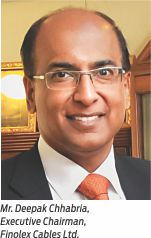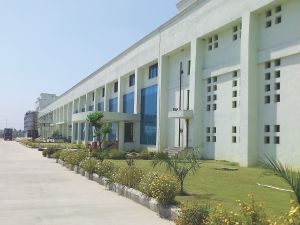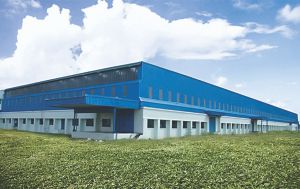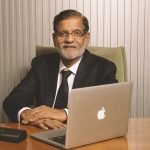Over the years, the leading manufacturer has smoothly transitioned from being an exclusive wire and cable maker to becoming a producer of the whole gamut of electrical products, including switches, MCBs, lighting products, and fans – thanks to its lasting commitment to technology and quality, which made it enter many landmark tie-ups and JVs with some of the leading global names like AT&T, Sumitomo, and more.
 Finolex Cables Ltd, India’s largest and leading manufacturer of electrical and telecommunication cables, is known for making products which stands true to the taste and need of the time. Wire and Cable India recently had a detailed interaction with Mr. Deepak Chhabria, Executive Chairman, Finolex Cables Limited where he told what all it takes to become Finolex, apart from leading the Indian wire and cable industry with pioneering technologies and quality benchmarks. Excerpts:
Finolex Cables Ltd, India’s largest and leading manufacturer of electrical and telecommunication cables, is known for making products which stands true to the taste and need of the time. Wire and Cable India recently had a detailed interaction with Mr. Deepak Chhabria, Executive Chairman, Finolex Cables Limited where he told what all it takes to become Finolex, apart from leading the Indian wire and cable industry with pioneering technologies and quality benchmarks. Excerpts:
Wire & Cable India: Please tell us briefly about the inception of Finolex, its evolution over the period of time, along with the major milestones achieved by the company.
Deepak Chhabria: Finolex was started by my paternal uncle Mr. P.P. Chhabria and my father Mr. K.P. Chhabria. The founders graduated from operating an electricals shop to electricals manufacturing, to become one of the India’s leading companies in the segment. The main company is Finolex Cables and the other group companies were formed later on.
Finolex Cables was incorporated in 1958. The name ‘Finolex’ was a portmanteau, coined from words ‘fine’ and ‘flexible’ as the fine copper was drawn to make the flexible cable, the company’s first product after incorporation. The group since then has grown to about INR 6,000 Cr turnover. I have worked all my life with Finolex Cables, starting out as an operator on the machine, after I came back from the US, to becoming the Executive Chairman of Finolex Cables. Basically, the turnover of the group, which I handle, is close to about INR 2600 Cr. There are many other companies in the group.
WCI: Please share some important landmarks in the journey of Finolex Cables. What was the idea throughout the journey?
DC: Finolex started out as the manufacturer of JFTC, a segment dominated by public sector. Finolex and Delton Cables were the first private sector players allowed to make the product. We started making the product to reach to a point where 90 percent of the company’s sales accrued from JFTC. This was about 18-20 years ago.
The era of JFTC came to almost sudden end with the advent of OFC. The JFTC crisis was not gradual slowdown in the demand but was rather an instantaneous decline. No one thought then that the concept of wireless phones and fiber optics would completely overpower JFTC-led telecommunication landscape. The sudden crisis led us to work something out as new product line and then we focused what is called LDC products, i.e. light duty cable product line, where auto cables, winding wires, flexible cables for the panel wiring, etc. are the part of portfolio. We built a brand in electrical products up to 1.1 KV and created a wide distribution network. Afterwards, communication cables, switchboard cables, co-axial cables, RF cables, etc. followed including fiber optic cable itself.
At the time when we were producing JFTC, we were just one-product-one-customer company, DoT being the sole buyer. This changed after market dynamic changed after JFTC crisis. The time was difficult for us as a company but it led to the much needed product diversification. We now have a complete product-basket. Product-wise, Finolex diversified both on electrical and communication cable sides. After cables, Finolex went ahead to transform the company into an electrical product company by expanding into electrical switches, MCBs, lighting products, and the last year, we launched fans and water heaters. Our product range now goes beyond cables. The volumes (of electrical products other than cables) are small, but it is building up quite decently. In the next couple of years, we are expecting a decent contribution in the turnover coming from these newer products.
The vision or the idea always was to transform the company from being purely wire and cable to becoming an electrical product company, also from being a B2B player to becoming a B2C player.
WCI: Would you like to elaborate on the strategy for developing the B2C part of the business? Five years from now, what percentage of business do you expect from non-cable part of the portfolio?
DC: When we talk about the strategy, let’s talk about the present distribution system. We have got around 4,000 distributors and 30,000 dealers. Moreover, though electrical shops keep the entire electrical product line, there are some other outlets, non-electrical in nature, which keep these products too. While launching these new products in the existing network, we realized also the need to build separate kind of network for each product line, covering all possible sales outlets for such products. The focus was brought on to each product line in order to grow to a large number. We have made distinct verticals with certain profit-center heads and a separate sales team for working out these channels and distributions. Wire and cable is one section; MCB and switches combined together forms another vertical held by a profit centre head. Lighting is a separate vertical, which is huge in range and you need separate sales teams not only in the network but even for projects to go after. They have to be focused. Then, we have fans and water heaters as a separate vertical.
 Going forward, we intend that each vertical has to have a large share with each vertical giving at least INR 100 Cr to start with. That’s the target. In the long term, we are looking for fans to have a huge market size. In the next five years, we intend to hit INR 500 Cr in fans. The strategy is very specific. Apart from producing bulk volumes for fans selling in Rs.1000 range, Finolex would try to gain a market share in mid-segment fans priced at INR 2000-2500 by making quality products. Many people are outsourcing and doing sales. But, we intend to have an established proper plant for the purpose.
Going forward, we intend that each vertical has to have a large share with each vertical giving at least INR 100 Cr to start with. That’s the target. In the long term, we are looking for fans to have a huge market size. In the next five years, we intend to hit INR 500 Cr in fans. The strategy is very specific. Apart from producing bulk volumes for fans selling in Rs.1000 range, Finolex would try to gain a market share in mid-segment fans priced at INR 2000-2500 by making quality products. Many people are outsourcing and doing sales. But, we intend to have an established proper plant for the purpose.
For water heaters, our target will be of INR 100 Cr. In switches, we launched two ranges earlier. One range which is the premium range, became popular and the other range which is semi modular was performing averagely in the market. We recently launched a third range which is a modular range, having good aesthetics and is positioned in between the entry level and premium segment. There is one more range which we are looking at, a touch type switch, which will come out shortly. In the switch segment too, the initial target is INR 100 Cr but this can grow to a larger number. All in all, we are looking at the five-year horizon. In the five years, if we are going to get 25 percent of the sales from these products, it will be a good achievement for the company. The wire and cable will grow along with it.
WCI: What is the idea behind your tagline ‘Behtar Electrikal ke liye’?
DC: All our past ads always talked about safety. We believe that a brand is built on safety. We have always taken care of that. Being in the wire business, we make our own compounds and have a proper compound division at Finolex Cables from inception. There are various grades of compounds based on the application. Also, one group company makes PVC resin.
We always design something that exceeds the product standard. If a customer is paying 5 percent more, then at least the life of the product should be 70-80 percent more. I think we are giving value to the customers. If we are offering a higher life and charging slightly more, there are so many customers who would appreciate it. Our tagline thus tries to convey all that we do to make our products reliable, including safety as fundamental quotient.
WCI: Finolex has done a lot of technological tie-ups with the global leaders. We would like to ask, what has been the strategy behind this? And, brief us about these technological tie-ups which you have done.
DC: We first tied up with Essex, Inc. (USA) in the 1980s for technologies for jelly-filled telephone cables. They were the world leader of JFTC at that time. It was a 15-year tie-up for technology based on fees and royalty. The technology was important for us as we were new in the field and had to address both the cost and productivity. Moreover, in the US, Essex was the largest consumer of copper and the largest producer of magnet wire. Being the largest manufacturer of magnet wire, they used to cast their own copper. We later set up a joint venture with them in India with their copper rod casting technology. Over the years, Essex got sold and we bought the shares making it a division of our company. We thus got two significant technologies from Essex over a period, first JFTC and later copper rod casting.
We also tied up with GE, U.S.A. for compounding and NSW, Germany, the world leader in PVC winding wires to work underwater in the submersible pump industry. NSW used a special grade of PVC and that particular application we learned from them. Among other remarkable partnerships, one with AT&T ranks high and was for OFC related technologies. The collaboration with this USA giant then was a major thing for us, which resulted in AT&T Finolex Pvt. Ltd., our OFC plant at Urse. After break-up of AT&T in various divisions, the cable business was named Lucent and thus the JV became Lucent-Finolex. Lucent was later acquired by a Japanese company and Finolex retained the plant in lieu of its shares, now a division of Finolex Cables.
Finolex always believed that backward integration to produce some crucial cable components is needed in order to stay competitive. We therefore started manufacturing 99.97% pure electrolytic grade copper in-house and later set up our own draw towers for making the fiber itself. This helps immensely in raw material security and quality control. We bought draw tower technology from Nextrom, the leading supplier at that time. We invested in draw towers when the cost of fiber used to be USD 100/fiber km, which is now in the range of USD 9 per fiber Km.
Initially, we bought performs from a Japanese company Shin-Etsu. And, later on, we bought from any source we wanted. Finolex however entered in a tie-up with Corning later as it needed a long-time technology partner because the fiber optics is very dynamic field. With Corning, it’s a marketing tie-up for selling fiber in the Country and Corning helped us with technology in our existing business to improvise it.
In power cables, we have a JV with J-Power (under Sumitomo, Japan). Finolex, for a long time, was mostly producing low-voltage and medium-voltage cables up to 33 KV. As making EHV was not possible on our own, we entered into a JV with J-Power to set up the plant at Shirwal, Pune. This ultimately took us to 500 KV. Nobody in India makes up to 500 KV except us. It’s a 51:49 venture; 51 percent owned by Sumitomo and 49 percent by Finolex Cables. The management control is with Finolex. Sumitomo looks at the export market. Our 400 KV power cable is out and is with KEMA for approval, which is to come soon.
WCI: Tell us something about the capacities you develop keeping a specific product line in mind. What factors do influence your expansion decisions?
DC: Some of the capacities are always overlapping. For example, if we are making house wiring or flexible cables, it will come from the same machine. You can increase on the one and decrease on the other, depending on the market realities.
Our tendency has always been that whenever we reach 70-75 percent of utilization capacity, we go for an expansion. We always try to stay ahead of the market because things peak in certain months and you need more capacity. We should not be out of products to service a customer. That’s our normal approach for any of the product lines. Our capacity expansion is continuous by adding lines and machines as per the specific product line demand instead of going for a large project every 5 or 10 years. That’s what we have done in the past and what we would continue doing.
There is an expansion going on at our Urse plant for solar cable. We are installing an e-beam facility with two e-beam machines along with putting up a separate extrusion line for the purpose. The two e-beams will cover not only solar cables but more product lines. Then, we are expanding the fiber optic cables. Its demand in the market is suddenly growing. We are doing a backward integration to make our own copper clad steel wire, which is used for co-axial cables. This is what is happening in the next 12 months. Besides, we are expanding LAN cable capacity and have just placed the machinery order a few days back. And, there is one new plant, which is not announced yet so can’t tell you the details.
WCI: How do you respond to the competition in the market? Also, tell us about the marketing strategy that you have adopted for your company.
DC: The USP of our product has always been quality, safety, and reliability. These are the three things we focus on and the company’s entire operation is based on this focus. Most of the machines we have in our company are imported. These machines are run by qualified engineers, not by workmen and laborers. We use labor just for packaging or movement of materials. We believe raw material, machinery, and man, the three Ms, are going to decide the quality. For us, the key part is quality and price is secondary. We are not running after a market where we are the cheapest with the highest volume. This is not the company’s strategy. There are some companies who would do that. Our strategy is to beget a quality, higher than the market standards as long as it makes sense.
We just ordered for the imported LAN cable machines, prices of which are many times higher than the local machines because they are the ones which are stable and consistent in long-run. We are looking at quality conscious customers, who are there for the long-run.
WCI: Geographically speaking, which regions do you cover currently? And over a period of time, how has the export and import of electrical goods evolved in our country?
DC: We sell pan-India. Since we began from selling in south, we are stronger there with the highest market share. Next is the west region because of our location in Pune. The north and east region is yet to be covered fully and we are working on building a strong distributor-dealer in these regions. The marketing strategies and promotions are currently aimed at that.
We have about 26 depots and sales offices. Connected online through the SAP, processing is quick. Creating a wide distribution system on pan-India basis is the fundamental marketing strategy. We make sure the product is available. We have a good presence over the television, through which we try to create a market pull for the end consumer. Finolex also makes sure the quality is the best in the industry.
Even though the export number is a very large for the Country, export from India is yet to become favorable in terms of wires and cables. At the peak time, we must have exported INR 100 Crores. Nowadays, it is a little less. Our labor cost is very less, a mere 3-3.5 percent of total cost, due to strong automation in our Plants. The advantage in India is lower labour salary. But since our labour cost is low due to automation, there are not too many savings to help us compete in exports to other countries. The high freight cost and entry duties in another country is also a deterrent. Even though the labor salary in India is half or quarter of developed regions, the export would only be marginally profitable. If the labor cost would have been in the range of 10 percent of the production cost, then export of such products would be easily possible. We have certain developed markets over the years in the Middle East and Europe where we regularly export. In times of worldwide shortage, like today in fiber, we get opportunities to export more.
Japan is happy to come to India as our partner and it’s targeting the Middle-East market for export because of favorable shipping time and cheap Indian labor. However, that’s not all; their idea is to take position in a large domestic market as priority along with some export viability. Exports from India do take place to some traditional overseas markets because of absence of local manufacturing. Moreover, exporting to European markets only on the basis of low labor cost is a little difficult.
We often talk about the advantages that our country has over China. Their power is cheaper, their labor cost is lower, and their productivity is simply superior – it is therefore difficult to figure out the advantage. We are expected to compete against China and sell in the international market, a very difficult thing to do. Moreover, our domestic market is still not as large and the plant capacity of the manufacturers here is not of world scale. China, on the other hand, not only has huge domestic markets with cost-effective supply-chain, but they export to the whole world as well. On raw material front too, India is expensive. However, as the time grows, with the Prime Minister’s ‘Make in India’ program and increase in the volume, we will become export-compatible. You will also see the supply chain cost coming down.
WCI: Generally industry has some genuine expectations from the Government. Representing the industry, would you like to highlight any expectation that industry may have with regard to the taxation system, cost of capital, infrastructure, credit system, or something like that?
 DC: I think the government has done a great job. We are very happy with the new GST tax system. In the organized sector, we have faced problems from the unorganized sector where the cost is low. They even cheat on taxes. I think all this will disappear with GST. We are already seeing some impact. For the organized sector, GST is a positive measure that the government has done. Overall, it has nothing to do with our particular sector. As volumes rise in any sector, cost will reduce, it will help everyone.
DC: I think the government has done a great job. We are very happy with the new GST tax system. In the organized sector, we have faced problems from the unorganized sector where the cost is low. They even cheat on taxes. I think all this will disappear with GST. We are already seeing some impact. For the organized sector, GST is a positive measure that the government has done. Overall, it has nothing to do with our particular sector. As volumes rise in any sector, cost will reduce, it will help everyone.
If you are looking at exports, you need to worry about the cost of money. For imports in India, as long as you can ensure it’s a level playing field and allows the domestic sector to grow then I think it’s a fair business. According to me, you shouldn’t have too much of protectionism. With free and fair trade happening, product cost goes down and quality comes up because of healthy competition. However, there mustn’t be unfair competition caused by unbridled imports. You can see that when you look back to License Raj, when cost were too high due to restrictive trade practices.
We have to balance our EXIM policy, where domestic industry is not harmed by imports. For example, the Chinese Government is giving exports benefits to its companies to sell their products in India whereas the Indian Government keeps a very low import duty without giving any appreciable export advantage. Our costs are what they are. This makes a domestic player uncompetitive. That is unfair. That’s what the Government has to keep an eye on. They should allow the domestic companies to grow and become large in volume.
WCI: What are your views on the technological trends? How has it evolved in the country and how will it further evolve?
DC: We want to stay ahead of our competitors in terms of technology. Finolex has been immensely successful in terms for acquiring various pioneering technologies over a period of time. This has largely been successful because of our constant exploration of the latest technology across the world. As a result, our company, since inception, has been able to forge some lasting tie-up and JVs with the leading technology owners, right from AT&T, Essex, NSW, Sumitomo, and so on. We have acquired many critical technologies and absorbed them completely to produce products that go with time.
WCI: There is appreciable growth in the wire and cable sector with the prospects of booming demand in future. Which are the segments you would bet on as leading the industry growth?
DC: I think in telecom, there are lots of tenders coming in. The capacity in the country may run short the way the tenders are coming in. Much of the telecom growth would be riding on the govt.’s initiated projects. From the private sector side, you see consolidation happening. So, demand for optic fiber cables for telecom looks healthy.
The solar sector is growing. We put up a small 5.5-megawatt project in our Urse factory to feed our plant and I have seen, from then to now, prices of the panels have come down. The project cost just keeps dropping. We are happy because we got our return from the time we put it. I think solar power consumption will rise with lowering in its cost. Storage of excess solar power is still a problem in India and which is very costly as of now. This needs to be sorted out.
Furthermore, I have seen a pickup in the EHV requirements. I think India needs to consume a lot more EHV cable. The requirement is there, both in the underground EHV cables and towers. The govt. needs to initiate projects to cater to those requirements giving a fillip to EHV cable consumption.



